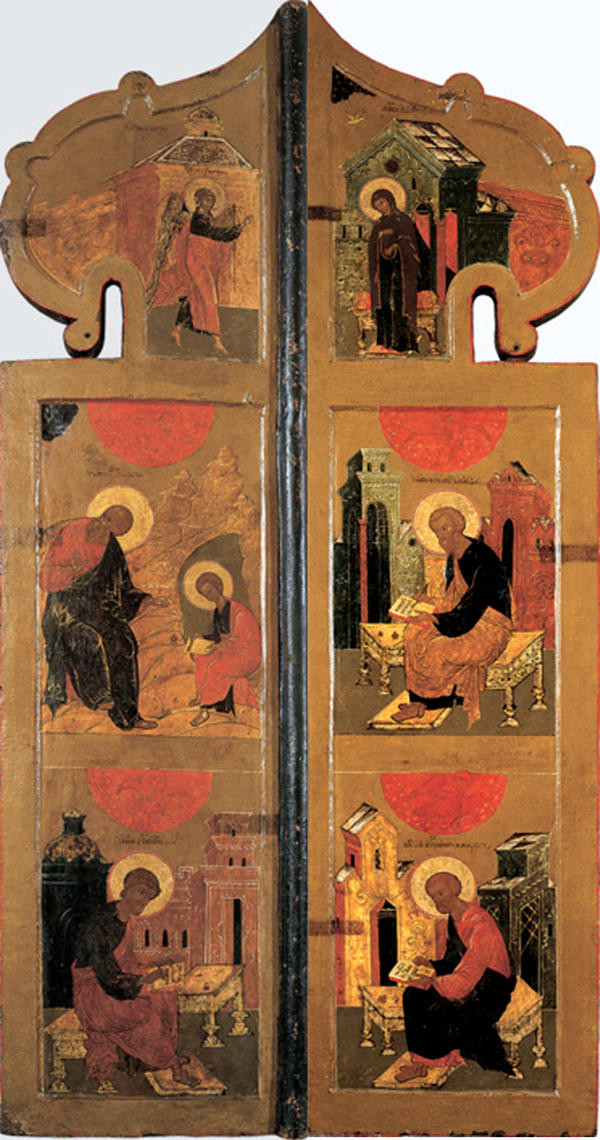In Russian Orthodox churches the Holy Doors are at the centre of the iconostasis and lead to the altar in the eastern part of the temple. There are two more sets of doors, called Deacon’s Doors, in the southern and northern parts of the altar. The holy sacraments, the church wine and bread symbolizing the body and blood of Jesus Christ, are brought out to the worshippers through the Holy Doors.
Holy Doors
Время создания
Mid-17th century
Размер
136,3x32 cm
136.3х32х3.9 cm
136.3х32х3.9 cm
Техника
Wood, tempera
1
Открыть в приложении#3
Unknown author
Holy Doors
#2
#5
The Holy Doors
#6
The Holy Doors could be carved or painted. Carved doors were decorated with medallions bearing images of saints, whereas painted doors had, as a rule, icons of the four evangelists. The hinged doors of the gate were fixed to pillars with images of archdeacons and holy hierarchs. The iconostasis above the Holy Door usually has an icon of the Eucharist, the scene of the ritual of communion.
The Holy Doors in the collection of the State Museum of Fine Arts of Khanty-Mansiysk were painted by Yaroslavl masters in the middle of the 17th century. Both doors are painted in accordance with the iconographic tradition. The ornate keel-type top shows scenes of the Annunciation: the Archangel Gabriel on the left door and the Theotokos on the right. The second tier shows St. John and St. Matthew the Evangelists, with St. Luke and St. Mark below.
The Holy Doors in the collection of the State Museum of Fine Arts of Khanty-Mansiysk were painted by Yaroslavl masters in the middle of the 17th century. Both doors are painted in accordance with the iconographic tradition. The ornate keel-type top shows scenes of the Annunciation: the Archangel Gabriel on the left door and the Theotokos on the right. The second tier shows St. John and St. Matthew the Evangelists, with St. Luke and St. Mark below.
#7
Technique
#9
Both doors are made of single planks of wood, commonly lime, ash or other non-resinous types of wood although in smaller churches scholars came across doors made of pine. The wood panel was usually covered by linen cloth, although sometimes the painting was done without it, with the surface of wood primed by the levkas, a mixture of chalk, glue and oil.
Icons were painted with tempera, the paint made of powdered pigments mixed with raw egg yolk. With the addition of some boiled linseed oil, the paint, when dried, had a satin gloss and cracked less over time.
#8
The background was painted with ochre made by mixing rust and clay. Lazurite pigment was used for blue tones and cinnabar for red. In these Holy Doors cinnabar was used in the red lining of the edge, or opush.
The Holy Doors came to Khanty-Mansiysk in 1998 acquired by the Generations Foundation of the Khanty-Mansy Autonomous District from the Gelos auction house. They were on display at the gallery of rarities and art treasures until in 2011 when the doors were transferred to the museum collection.
The Holy Doors came to Khanty-Mansiysk in 1998 acquired by the Generations Foundation of the Khanty-Mansy Autonomous District from the Gelos auction house. They were on display at the gallery of rarities and art treasures until in 2011 when the doors were transferred to the museum collection.
#10
State Museum of Fine Arts of Khanty-Mansiysk
читать дальшескрыть
00:00
00:00
1x
Holy Doors
Время создания
Mid-17th century
Размер
136,3x32 cm
136.3х32х3.9 cm
136.3х32х3.9 cm
Техника
Wood, tempera
1
Открыть в приложении
Поделиться



